Fiasco Italo-Brittanico
Part 10: The 90CA in more detail
Author
- Henri Greuter
Date
- April 17, 2009
Related articles
- March-Alfa Romeo 90CA - Fiasco Italo-Brittanico, by Henri Greuter
- Introduction
- Part 1: Alfa's inverse Midas touch
- Part 2: Indy teams keep on March-ing
- Part 3: The Indy project that became a blackmail project
- Part 4: Patrick Racing, a brief history up to 1989
- Part 5: 1989 - Alfa picking up the pieces
- Part 6: 1989 - Winning major prizes on the road to losing everything
- Part 7: 1989 - The first Alfa Romeo-powered CART racer
- Part 8: 1989 - A hopeful start for Alfa Romeo
- Part 9: Preparing for 1990
- Part 11: Exhaust solutions a 'waste' of effort?
- Part 12: 90CA on active duty - up to halfway into the month of May
- Part 13: 90CA on active duty - the early part of the second week of practice at Indianapolis
- Part 14: 90CA on active duty - wrestling through the second week of practice and qualifying
- Part 15: 90CA on active duty - about the Alfa Romeo V8 engine
- Part 16: 90CA on active duty - the last part of 'Indianapolis'
- Part 17: 90CA on active duty - after Indianapolis
- Part 18: The end of the road for March in CART and as a whole
- Part 19: The left-over hardware and where to find it
- Part 20: Final verdict on the March-Alfa Romeo 90CA
- Appendix I: Specifications
- Appendix II: Results and scores
- Appendix III: March-Alfa Romeo 90CA-related collectables and memorabilia
- March-Porsche 90P - The last oddball at the Indianapolis Motor Speedway, by Henri Greuter
Who?Roberto Guerrero What?March-Alfa Romeo 90CA |
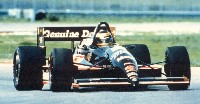 |
Why?
On seeing the March-Alfa Romeo 90CA the first impression is likely to be something like “compact front half, low side pods for starters.”
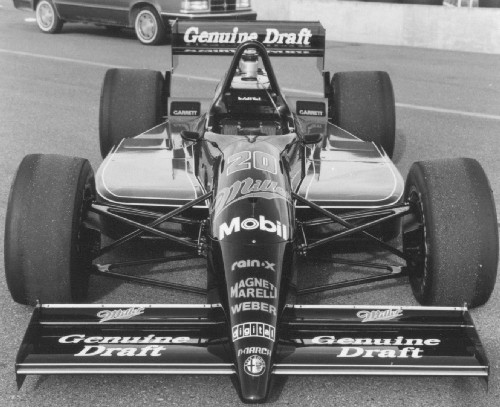
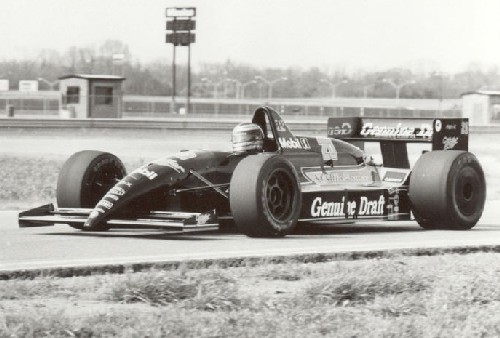
Indeed, the front half of the car definitely looks like it was inspired by the Porsche-powered March 89P. Given the results of that car of which the chassis was believed to be the best part of the car, that is reason enough for high hopes.
The information released on the car in the Alfacorse press kit and the Miller Genuine Draft Indy Car team's media guide enables us to derive the following details about the car.
The design was by John Baldwin, according the new 1990 CART rules. These new rules mandated that the maximum height of the floors of the sidepods, which generated the downforce using ground effects, was reduced from 10 to 8 inches (250 to 200mm) in order to reduce downforce and hence cornering speeds. In the Alfacorse presskit, Baldwin stated that the chassis “provides the ideal home for the Alfa Romeo Indy V-8.”
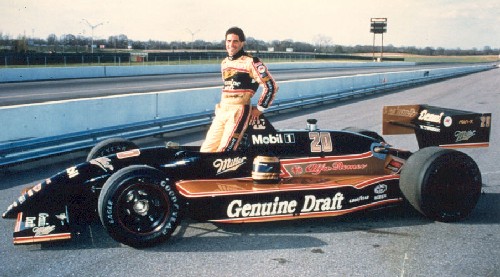
The car was designed with both road and oval racing in mind, the speedway car having a slightly longer wheelbase. The 90CA could be built up in four slightly different versions according the needs demanded by the track it was to be used on.
The monocoque was an aluminium and carbon fibre combination, utilizing the high uni-directional carbon- fibre technology developed by March Engineering. The design was aimed at providing maximum stiffness in the tub as well as the tub/engine connection area.
The transmission had been designed specifically to be combined with the Alfa V8 and also provided a stiffer connection to the engine to permit an optimum low position of the turbocharger. The gearbox had six forward speeds, one reverse and a differential that could be adjusted without dismantling the box.
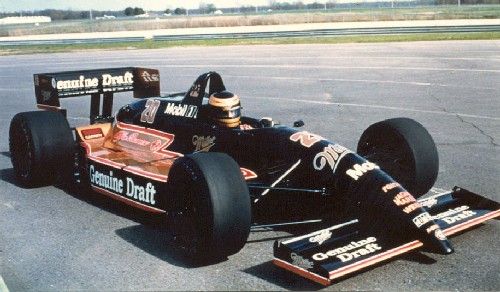
The March90CA seen from aside. Here, in road-circuit conversion the ramps at the end of the sidepods appear to be very, very steep. (Photo Alfacorse)
Both front and rear suspension were pushrod-operated, developed to minimize pitch and increase stability. The wishbones had a new design of cast magnesium uprights. Wishbones were single at the front, double at the rear. The suspension units (coaxial helical springs with telescopic shock absorbers) were mounted inside the tub and were operated by a pushrod/rocker system.
The bodywork was described as being kept as smooth as possible in order to minimize airflow disturbance. Engine cover and sidepod tops were a one-piece moulding with integrated mouldings of the air outlet ducting. These outlet ducts were also used as structural components. The underwing was also a single piece. Cooling was taken care of by water radiators and oil/water heat exchangers, one in each sidepod.
A total of four 90CA chassis were built at the Colnbrook March facilities.
As for the Alfa Romeo Indy V8 engine: according Alfacorse, no less than four different engine configurations had been tried since the racing program had started the previous June. Early in 1990 the car still had to use the Phase II (also called Evolution II) unit, which was still a four-valve-per-cylinder design. A Phase III engine was designed which was to be a five-valve-per-cylinder engine with three inlet valves. This technology was already being applied in Formula One, FIAT partner Ferrari being one of the constructors building five-valve engines.
The 1989 engines had used Garrett turbochargers, built according to the rules as issued by CART for these devices. The Garrett was retained for 1990. The turbo was located deep within the car. The air intake was positioned within the right-side sidepod. The exhaust flow out of the turbine was discarded through a tub, hidden under the bodywork of the left sidepod, positioned between the bodywork and above the underfloor. The exhaust flow was released very close to the left rear wheel.
The V8 had only a single wastegate and it was positioned above the turbo. The flow out of the wastegate was directed upwards and released at the left rear-end corner of the engine cover, the pipe clearly visible, sticking out of the bodywork located even higher and as a result of that the engine cover had to remain higher up. This arrangement made the rear-end part of the engine cover look rather high. The low position of the turbocharger had enabled a lower engine cover but the wastegate arrangement undid all these possibilities.
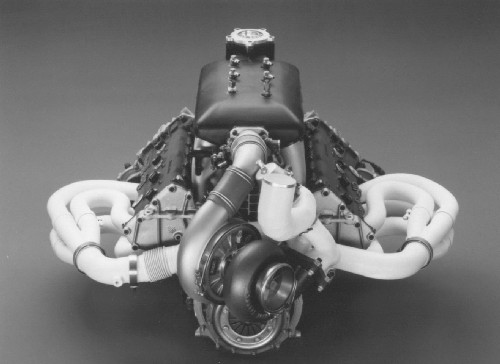

The 1990 Alfa Romeo Indy V8 “Phase II” (photo: Alfacorse)
Altogether, it appeared like being a formidable effort. But on a second look, however, the car looked far and far less effective than its PR bulletins suggested.
“How can they be so wrong”
Indianapolis, Thursday, May 17th, 1990. At long last, my first close encounter with an intact March-Alfa Romeo 90CA.
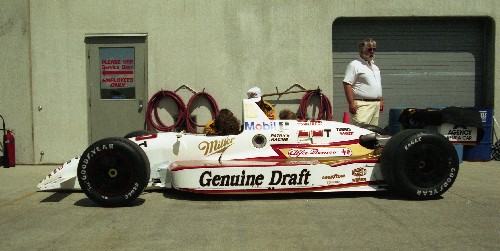
The March 90CA in Superspeedway trim, seen from aside. (Photo HG)
When watching the March-Alfa 90CA closely for the first time a song came up with me instantly. The title of this song was “So wrong”, the artist is listed as Patrick Simmons and the lyrics were sung by Michael McDonald. It was released as a 45rpm single in the Netherlands in the spring of 1983 but barely made it into the top 50.
The lyrics of the song’s chorus were:
“So wrong, so wrong, how can they be, so wrong, so wrong?”
“How can love be so wrong, I don’t know why.”
Looking at the 90CA this part of the song went through my mind. As for the front part, I had to admit that looked promising.
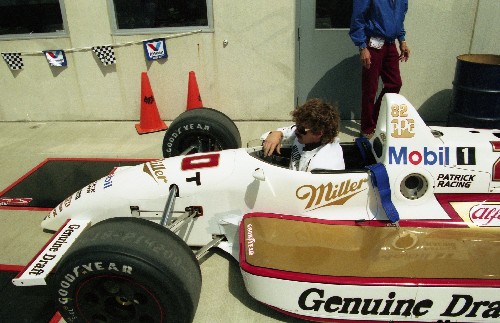
Inspired on the 89P, the front end of the 90CA looks good enough. (photo HG)
But behind the fuel cell, the car looked, at least to me, a mess.
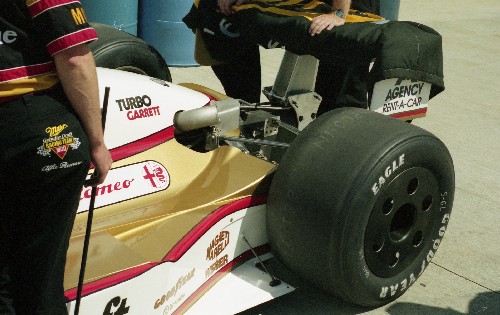
The rear part of the 90CA, including the wastegate exhaust location. Shielding the bodywork against the heat was vital. The ramps at the end of the sidepods are not as extended as seen on the pictures of the car in road trim. But they certainly must have created additional drag and disturbed the airflow to the rear wing. (Photo HG)
And what doesn’t look good at first sight hardly ever works.
I am no aerodynamicist, I will admit to such instantly. But one interesting detail about the March-Alfa was that it had no horizontal fins in front of the rear wheels to provide downforce and/or shade the rear wheels. Funnily enough, the Porsche-powered March 90P also ran without such devices. But of the four newly designed cars, the two different Marches were the only cars not using such fins.
I had not seen any pictures of the March 90CA yet. And that is why, much to my surprise, I noticed that at the rear end of the sidepods the bodywork went upwards like two ramps between the centre fuselage and the rear wheels. These ramps were to keep the upper suspension wishbones out of the air stream. But because of that the airflow was pushed upwards instead of being directed straight to the rear wing. How much the efficiency of the rear wing was compromised because of the upward airflow remains a mystery. The ramps were kind of moderate on the car in the Indianapolis Superspeedway trim, but the pictures in the press kit showing the car in road trim the ramps were far more significant.
The March-Porsche 89P had also used such sidepod end ramps on several occasions during the 1989 season, in particular on high downforce tracks. Thus it wasn’t an entirely new development for March. Yet they had not been used at Indianapolis. And the two 89P cars that appeared at the Speedway in 1990 did not have them either.
Remembering the statements by Dave Reeves made at Laguna Seca in 1989, it is difficult to figure out how March claimed to have an advantage because of the small Alfa engine and then come up with, even at first sight, such a questionable design of sidepod aerodynamics.
But it was even worse than just this.
Seen from the side, it appeared as if the engine cover of the March 90CA sloped down far less, thus in effect being higher than on any other car entered including the elderly ’87 vintage Lolas. Yet another detail that looks as if it would hamper rear-wing efficiency.
Already as early as 1987, Lola and March had succeeded in building cars which had their turbos low within the chassis, between the final drive and the engine. Some types had their turbo and wastegate outlet on the left side, but there were also designs of turbo and wastegate location in the heart line of the car, the exhaust flow running over the gearbox on the centre line of the car.
The March-Alfa, however, had its wastegate pipe sticking out, offset to the left. And perhaps it appeared to be located at such a high level because of the low sidepods of the car. Anyway, the gas flow appeared to be released in what was already a turbulent area because of the upswept airflow, due to those sidepod ramps.
Maybe the turbo was located low within the car. But the wastegate arrangement appeared to be far less ideal and certainly very poor compared to the more elegant solutions that Lola and Penske had found for their new car.
In the Lola T90/00 the turbo had gone as low as possible between the engine and the final drive, hidden well within the spacer. The Lola also had its exhaust flow released on the left side of the car but this was released in the area between upper deck and under floor. The main exhaust flow out of the turbo was handled on a similar manner within the March 90CA. But the Lola and the Penske used wastegates for each bank of cylinders, the flow being directed to the end of the sidepods, hidden under the bodywork. Apart from this being a more elegant manner to discard the gas flow, it also brought the mass of the wastegates lower within the car and enabled lower, smoother engine covers.
The wastegate exhaust flow solutions applied on the March 90CA looked far less elegant, and even questionable, even when compared to elderly Lola and March models. On first sight, even for those not knowledgeable on the topic of designing racing cars, the March-Alfa Romeo 90CA didn’t make a great impression, compared to its rivals at the tracks.
I had never seen the forerunner of the 90CA, the 89CE in real. Yet based on the pictures I had seen of this car, the 89CE looked bigger and larger to the more compact 90CA. But somehow, to my eyes, the 89CE, despite its 88C background, was at least at first sight a better looking car than the 90CA.
Nevertheless, no doubt that the 90CA had to be a better competitor than the better-looking 89CE. Remember that the hybrid 88C was rated as being marginally better than the 89CE. But somehow the 90CA appeared even more doubtful as a package compared to its opponents than the 88C had ever appeared in 1988 against its opponents.
